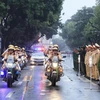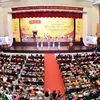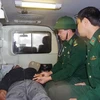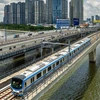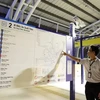The HCM City Management Authority for Urban Railways (HCM City-MAUR) is showcasing a model locomotive for the nation and city's first-ever underground line, Metro, soliciting comments from citizens and city leaders.
After inputs are gathered on the kind of train they want to bring into operation in 2020, they will be conveyed to the manufacturer.
As the underground line, whose Route 1 will commence operation first, will connect the city's commercial district and its outlying areas in the east, the authority wants the design of the locomotive, imported from Japan, to boost development in the eastern region.
Explaining the design of the model locomotive, HCM City-MAUR noted that the vehicle's front end is being designed to curve towards the base. Also, the curved painted line added to its front lights is meant to highlight the train's three-dimensionality and energy, while its blue colour signifies its youthfulness and power, besides being visually pleasing.
The large number 1 on the train not only represents the route itself, but also gives the impression of security, the authority emphasised, adding that this design represents an element of modernity in the first-ever underground transit system in Vietnam.
According to the plan, the urban railways authority will import 17 cars from Japan, where they will be manufactured, to serve Route 1 alone.
Each train will comprise three cars, with a total length of 61.5m, with each capable of transporting more than 300 passengers and every two of them supported by motors.
The trains will be connected with the national electric grid, and will be provided with sufficient energy from the stored generator to run for three hours – plenty of time to reach a station safely – in case of a power outage.
With large windows and four doors on either side, the body of the cars will be made of aluminium and stainless steel. The cars will be air-conditioned and will have reserved space and specialised equipment available for people with disabilities in wheelchairs. These will be separated with glass partitions installed to demarcate the seating areas.
Furthermore, the cabins of the train drivers, which will be completely closed and located at the ends of the trains, will be where the drivers will keep an eye on passengers through cameras and act in case of any untoward situation.
The underground locomotives will travel at a speed of 110km/hr on the elevated railroad and at 80km/hr when underground.
They will run automatically on Japanese technology, meeting international standards, which means the trains will not have staff catering to the passengers onboard.
Tickets will have to be collected at the station gates before boarding.
Moreover, train services will be offered within intervals of five minutes during off-peak hours and within intervals of two minutes and 10 seconds during rush hours, with a mere 30-second halt at stations.
Smoking and eating will not be allowed onboard the trains.
The first train is expected to be brought from Japan to Vietnam in late 2016, following which the remaining 16 will be shipped.
Some 400 workers and engineers will be trained to operate and maintain the trains for Route 1 alone, the construction of which began in August 2012; it is scheduled to be completed in 2019 and commence operation in 2020.
Stretching from Ben Thanh to Suoi Tien through the city's districts of 1, 2, 9, Binh Thanh and Thu Duc, as well as through neighbouring Binh Duong province's Di An district, Route 1 covers a distance of 20km.
The underground section of the route is 2.6km long and includes three stations – Ben Thanh, Municipal Theatre and Ba Son.
The surface section of the elevated railroad runs for more than 17km with halts at 11 stations. These include Van Thanh Park, Tan Cang, Thao Dien, An Phu, Rach Chiec, Phuoc Long, Binh Thai, Thu Duc, Hi-Tech Park, Suoi Tien, and Suoi Tien Bus Station.-VNA
After inputs are gathered on the kind of train they want to bring into operation in 2020, they will be conveyed to the manufacturer.
As the underground line, whose Route 1 will commence operation first, will connect the city's commercial district and its outlying areas in the east, the authority wants the design of the locomotive, imported from Japan, to boost development in the eastern region.
Explaining the design of the model locomotive, HCM City-MAUR noted that the vehicle's front end is being designed to curve towards the base. Also, the curved painted line added to its front lights is meant to highlight the train's three-dimensionality and energy, while its blue colour signifies its youthfulness and power, besides being visually pleasing.
The large number 1 on the train not only represents the route itself, but also gives the impression of security, the authority emphasised, adding that this design represents an element of modernity in the first-ever underground transit system in Vietnam.
According to the plan, the urban railways authority will import 17 cars from Japan, where they will be manufactured, to serve Route 1 alone.
Each train will comprise three cars, with a total length of 61.5m, with each capable of transporting more than 300 passengers and every two of them supported by motors.
The trains will be connected with the national electric grid, and will be provided with sufficient energy from the stored generator to run for three hours – plenty of time to reach a station safely – in case of a power outage.
With large windows and four doors on either side, the body of the cars will be made of aluminium and stainless steel. The cars will be air-conditioned and will have reserved space and specialised equipment available for people with disabilities in wheelchairs. These will be separated with glass partitions installed to demarcate the seating areas.
Furthermore, the cabins of the train drivers, which will be completely closed and located at the ends of the trains, will be where the drivers will keep an eye on passengers through cameras and act in case of any untoward situation.
The underground locomotives will travel at a speed of 110km/hr on the elevated railroad and at 80km/hr when underground.
They will run automatically on Japanese technology, meeting international standards, which means the trains will not have staff catering to the passengers onboard.
Tickets will have to be collected at the station gates before boarding.
Moreover, train services will be offered within intervals of five minutes during off-peak hours and within intervals of two minutes and 10 seconds during rush hours, with a mere 30-second halt at stations.
Smoking and eating will not be allowed onboard the trains.
The first train is expected to be brought from Japan to Vietnam in late 2016, following which the remaining 16 will be shipped.
Some 400 workers and engineers will be trained to operate and maintain the trains for Route 1 alone, the construction of which began in August 2012; it is scheduled to be completed in 2019 and commence operation in 2020.
Stretching from Ben Thanh to Suoi Tien through the city's districts of 1, 2, 9, Binh Thanh and Thu Duc, as well as through neighbouring Binh Duong province's Di An district, Route 1 covers a distance of 20km.
The underground section of the route is 2.6km long and includes three stations – Ben Thanh, Municipal Theatre and Ba Son.
The surface section of the elevated railroad runs for more than 17km with halts at 11 stations. These include Van Thanh Park, Tan Cang, Thao Dien, An Phu, Rach Chiec, Phuoc Long, Binh Thai, Thu Duc, Hi-Tech Park, Suoi Tien, and Suoi Tien Bus Station.-VNA






